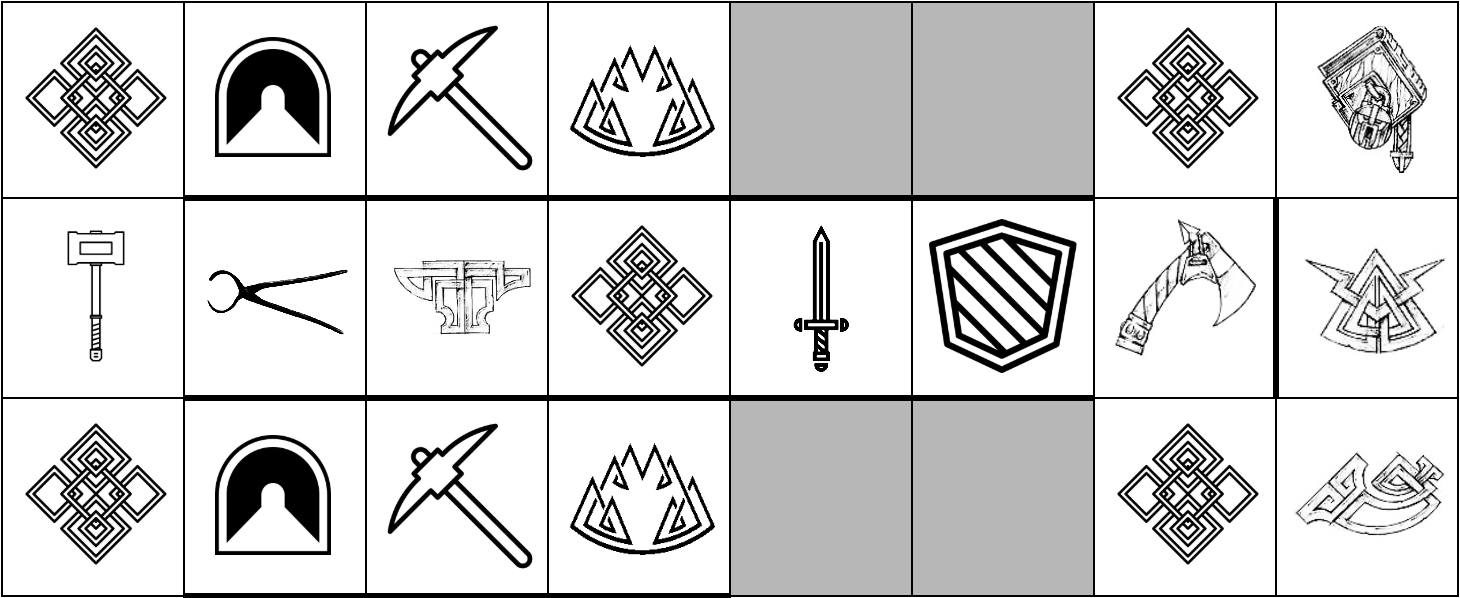The Dwarven Game of Ur
A popular game amongst Dwarves across the strongholds, Ur combines chance and strategy, with a background of cultural values.
Components and tools
The Game Pieces
Each player uses seven stones, typically dark for one player and light for the other. They are typically circular, with rounded edges. In some cases each stone will have a rune carved into it. These runic stones may then be used in other games, or in divination rituals.The Dice
The game is played with four tetrahedral dice [shape of a standard d4]. Rather than numbers on the faces, these dice have two of their points coloured. Typically the dice are dark stone that have had two points lightened, though sometimes light stones with dark pips are used.The Board
The board itself is a three by eight grid, used to form two partially-overlapping tracks that the players must move their pieces along. It will often be carved into a large stone table in a public gathering area. Sometimes it will be carved into a stone slab that can be kept in the family home. Another common form is for it to be carved into wood to be carried by travelers. The exit and entrance squares of each player (four) are often carved away. The other squares will be carved with symbols in the local style. Every fourth square is a "stronghold", which is significant to gameplay. The others feature a progression of symbols that are only of cultural significance.The Symbols
As described above, the board has two partially-overlapping tracks. Each track is made up of four runs. Each run concludes with a stronghold. The first run is safe territory for the player, the rest are in conflict. The symbols of the first run: Mountain, Pick, Tunnel, Stronghold.The foundation of a Dwarven stronghold is it's safe fortifications underground. Hill dwarves will refer to the first square as "Hill" rather than "Mountain", though the basic forms of the symbols are the same. The symbols of the second run: Hammer, Tongs, Anvil, Stronghold.
The growth of a Dwarven stronghold depends upon it's craftsmen. The symbols of the third run: Sword, Shield, Axe, Stronghold.
The safety of a Dwarven stronghold depends upon it's ability to defend itself in battle. The stronghold of this run takes a turn toward the enemy's exit. The symbols of the fourth run: Duty, Strength, Honour, Stronghold.
The future of a Dwarven stronghold depends up on these core Dwarven values. The order in which they are crossed depends on which side of the board the player is using.
Symbol Variations
Some boards will feature simple, abstract symbols. Some will have a high level of detail - it may even be possible to identify specific strongholds, historic artifacts or mountain ranges.As an example, a board carved into a large block in the grand hall of the Krugburim stronghold may have the following details:
- Both "mountain" squares carved to depict a profile of the Burim mountain range, one as seen from the south, one as seen from the north.
- The central "Stronghold" square carved to reflect the architecture of the main gates of Krugburim.
- The other "Strongholds" carved to reflect the main gates of the other dwarven strongholds.
- The "Sword", "Shield" and "Axe" squares carved to match the appearance of a specific weapon wielded by heroic figures from each of the main clans of the stronghold.
- The "Hammer", "Tongs" and "Anvil" squares showing recognisable depictions of tools used by master craftsmen of other clans in the stronghold.
Observance
Gameplay
The game is for two players and the objective is to move all of your pieces onto, around and off the board.On your turn, you roll the four dice and add up the marks. You can move one piece exactly that many places (either a piece on the board, or a piece in your beginning area). The piece can’t land on another of your pieces or on an enemy piece that’s on a stronghold. It's only possible to leave the board on an exact roll. If you land a piece on a stronghold you may take another turn. You follow the path from the your "in", along the shared centre and then to “out”. Landing on an enemy piece puts them back to their inbound pile. If your roll gives you no legal move, you miss out this turn.
Construction
The carving of a board and pieces is generally a significant and personal act. A clan might establish its significance by commissioning a large block in a central space to be carved by a master. Or a new recruit may carve themself a simple wooden board during their training. With thanks to Tom Scott and Irving Finkel https://www.youtube.com/watch?v=WZskjLq040IRemove these ads. Join the Worldbuilders Guild



Comments